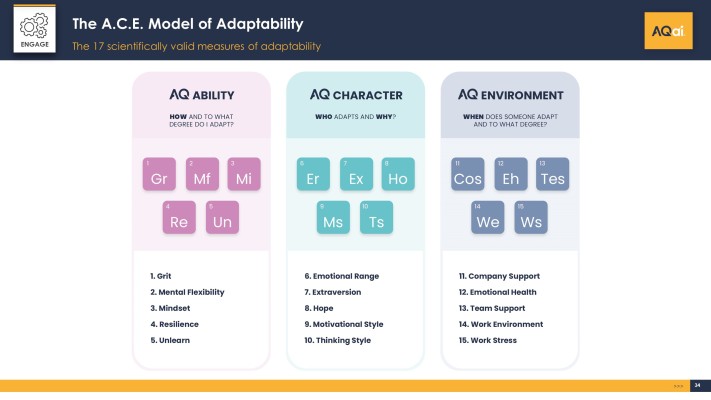A Journey Through the ACE Model
In the ever-shifting sands of the business landscape, adaptability isn’t merely a virtue; it’s the very marrow of survival and success. Yet, for countless business owners and managers, adaptability remains locked within an enigmatic “black box”—a complex puzzle whose pieces are hidden from view. It’s time to shine a light into this abyss and reveal the contours of adaptability through the prism of the ACE Model, a framework meticulously crafted by AQai and championed by Ira S Wolfe. This journey is not just about understanding; it’s about transformation.

A is for Abilities: The Bedrock of Adaptability
Imagine adaptability as a tapestry, with its first threads being the Abilities — Grit, Resilience, Mindset, Mental Flexibility, and Unlearning. These are not just skills but the essence of adaptability, woven into the fabric of our professional selves.
- Grit speaks to the perseverance and passion for long-term goals. It’s the fuel that keeps us pushing forward, even in the face of setbacks.
- Resilience is the rubber ball of human qualities; it’s about bouncing back from failures and setbacks with even greater strength.
- Mindset encompasses the growth perspective that sees challenges as opportunities to learn rather than insurmountable obstacles.
- Mental flexibility is the keenness for delving into the friction between differing viewpoints, and an openness to considering various perspectives.
- Unlearning represents the courage to let go of outdated beliefs and practices, clearing the slate for innovation and insight.
C is for Character: Sculpting the Adaptive Mind
As we delve deeper into the black box, we encounter Character — Extraversion, Emotional Stability, Hope, Motivating Style, and Thinking Style. This dimension shapes how we internally navigate the waters of change.
- Extraversion impacts how we draw energy from the external world, facilitating adaptability through proactive engagement with other people and engaging in new experiences.
- Emotional Stability is our anchor in the storm, ensuring that when the waves of change crash against us, we remain undaunted.
- Hope acts as our compass, guiding us through the fog of uncertainty towards the shores of possibility.
- Motivating Style reflects whether individuals are driven by a ‘play to protect’ approach, focusing on safety and risk avoidance, or a ‘play to win’ mindset, where taking calculated risks for greater rewards is preferred.
- Thinking Style differentiates between those who see the big picture (‘forest”), focusing on overarching themes and connections, and those attentive to the details (“trees”), meticulous in dotting the i’s and crossing the t’s.
E is for Environment: Cultivating the Ecosystem of Adaptability
The final key to unlocking the black box is Environment — Company Support, Team Support, Work Environment, Emotional Health, and Work Stress. This is the realm where culture and context converge, shaping the terrain on which adaptability either flourishes or flounders.
- Company Support highlights the perception of management’s commitment to team member well-being. from resources to recognition.
- Team Support emphasizes the role of managers, co-workers, and social networks within the workplace in providing emotional and practical support for adaptive behaviors.
- Work Environment underscores the significance of organizational systems, practices, and processes that foster innovation, flexibility, and learning.
- Emotional Health points to the degree of psychological safety within the organization, crucial for promoting positive emotions and managing negative ones.
- Work Stress acknowledges the tension between job demands and one’s ability to manage dual roles of workplace stress: overwhelm and underwhelm.
The Odyssey of Adaptability
Merging the foundational insights from our initial exploration with the detailed tapestry of the ACE Model, we embark on a narrative journey that transcends mere understanding. It’s an odyssey that transforms the enigmatic black box of adaptability into a glorious beacon of resilience, innovation, and agility.
Envision an organization where the principles of Abilities, Character, and Environment are not just acknowledged but actively cultivated. This is a place where employees are not merely workers but navigators of change, empowered by their grit and resilience, guided by a hopeful and stable character, and supported by an enriching and nurturing environment.
This journey through the ACE Model illuminates the path forward, offering not just a blueprint for adaptability but a manifesto for the future of work. For business owners and managers, the quest for adaptability is no longer a daunting challenge but an exhilarating adventure into the heart of what it means to thrive in an ever-changing world.
As I conclude this exploration, the black box of adaptability stands open, its secrets revealed. It’s an invitation to step into the light of understanding and action, to weave the principles of the ACE Model into the very DNA of our organizations, and to chart a course toward a future defined by resilience, flexibility, and unbounded potential. The journey of adaptability is ours to embark upon, a voyage that promises not just survival but triumph in the face of the unknown.






